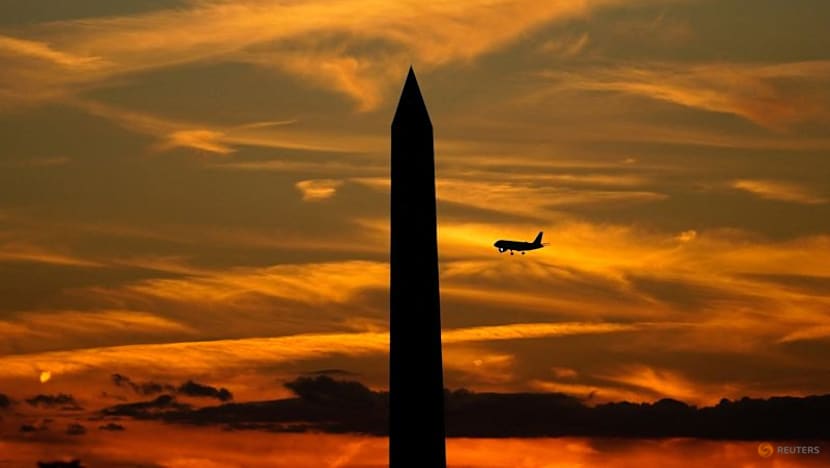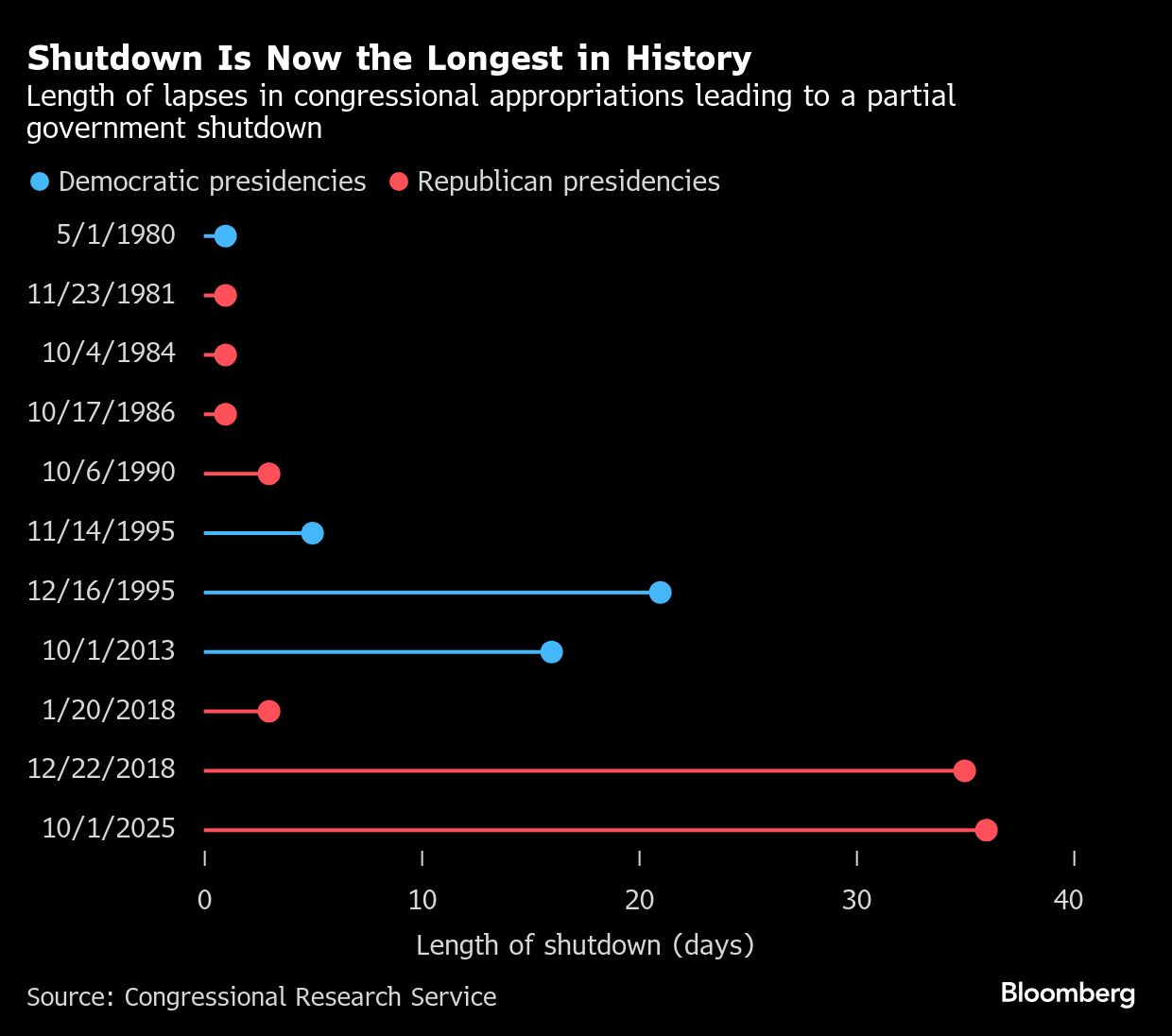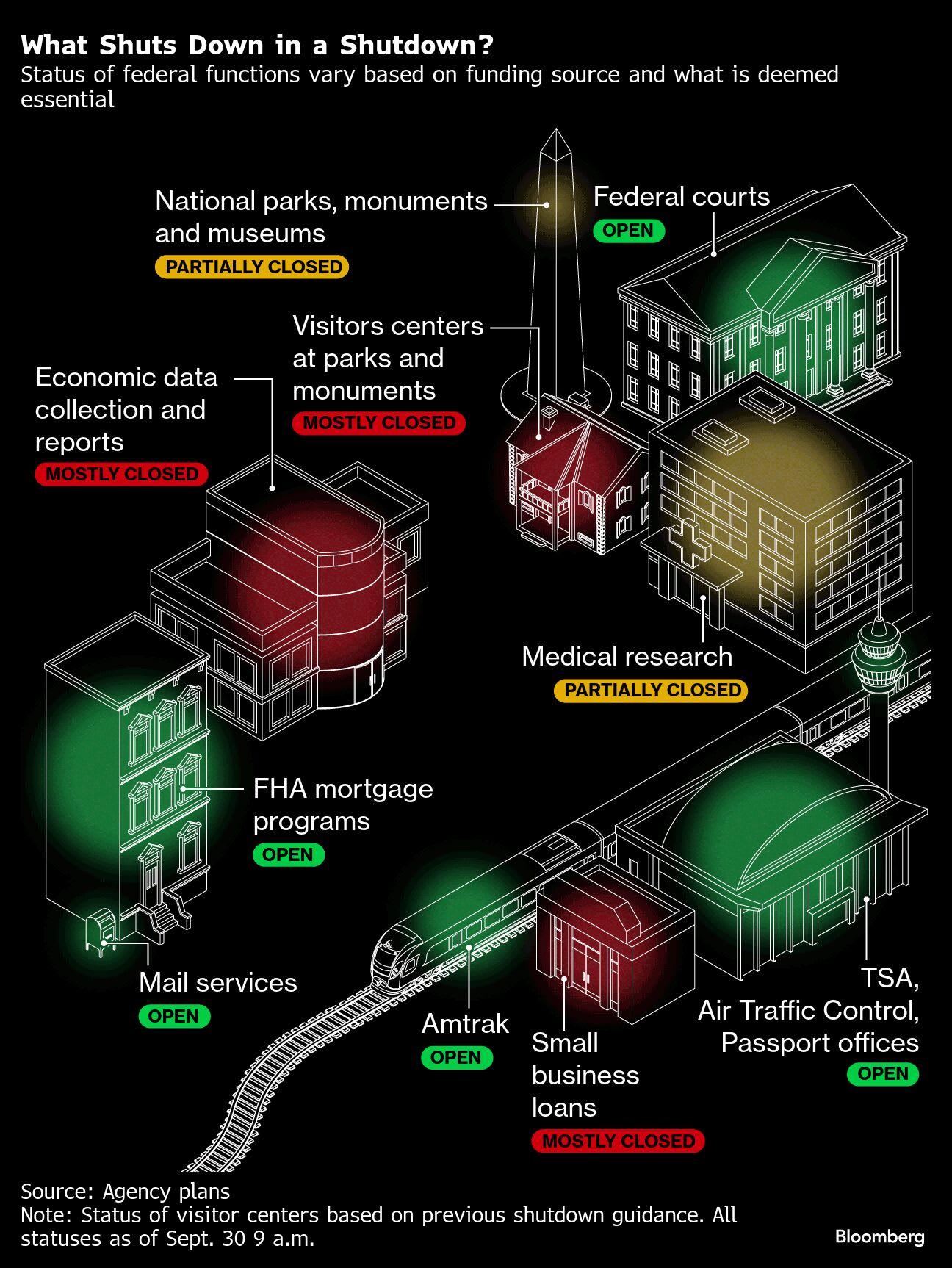The US government shutdown is the longest ever. Why does this keep happening?
The latest government shutdown in the US is the longest one in history. Here’s what to know about how they work and what they mean for government services.

A commercial aircraft flies past the Washington Monument during a partial government shutdown in Washington, DC, US on Oct 2, 2025. (Photo: Reuters/Nathan Howard)

This audio is generated by an AI tool.
Government shutdowns have become a recurring feature of US politics, the product of partisan standoffs over spending that force federal agencies to halt a wide range of services.
The latest shutdown - the third under President Donald Trump across his two terms - began at midnight on Oct 1, when Congress failed to pass a stopgap funding measure, triggering the nation’s first government closure in almost seven years. On Nov 5, it entered its 36th day, making it the longest shutdown in history.
Democrats are demanding that a stopgap Bill include an extension of Affordable Care Act premium subsidies and a reversal of Medicaid funding cuts - conditions Republicans have rejected, leaving the two sides deadlocked and the shutdown unresolved. Democrats also want new restrictions on Trump’s ability to refuse to spend money appropriated by Congress.
Since the shutdown began, the White House has moved to terminate roughly 6,000 federal workers and suspended funding for clean energy and transportation programs in Democratic-led states.
The layoffs would represent the first large-scale ouster of federal employees during a funding lapse in modern history. Unions have sued to block the terminations, arguing they’re illegal during a shutdown, and a federal judge ordered the Trump administration to pause the planned terminations.
Here’s what to know about how shutdowns work and what they mean for government services.
Why does the government shut down?
The US government runs on 12 appropriations Bills passed each year by Congress and signed by the president.
In fiscal years like the current one, when all 12 Bills aren’t adopted by the Oct 1 start of the fiscal year - the current count is zero, for those keeping score - Congress and the president keep the machinery of government humming by passing short-term extensions of current funding, known formally as continuing resolutions, or CRs. If they can’t agree to a CR, the US government has what’s called a funding gap, and federal agencies may need to take steps to shut down.
For the last fiscal year, Congress passed three such temporary funding patches, with the final one coming in March. At the end of September, they failed to pass a stopgap for the new fiscal year, triggering a shutdown.

How many times has this happened?
There have been 15 shutdowns since 1981. (Before 1981, agencies operated mostly as normal during funding gaps, their expenses covered retroactively once a deal was reached.)
The second longest shutdown in US history - over Trump’s insistence on adding US$5.7 billion to the budget for a wall on the border with Mexico - spanned 35 days in late 2018 into early 2019.
Shutdowns over spending disagreements are different (and less grave) than what would happen if the US breached its debt ceiling and defaulted on some of its obligations. That’s never happened, though the US came close in 2023.

What does a shutdown mean?
It means many, though not all, federal government functions are suspended, and many, though not all, federal employees are furloughed. Services that the government deems “essential”, such as those related to law enforcement and public safety, continue. These essential employees typically work without pay until the shutdown ends. In 2019, Congress passed a law guaranteeing that federal workers who are furloughed will receive back pay once the government is funded again.
About 650,000 federal workers have been furloughed since the start of the shutdown, and about 600,000 federal employees are working without pay. The White House budget office has advanced a novel legal theory that it doesn’t need to pay furloughed workers when the government reopens unless Congress passes a new provision authorising payment.
On Oct 15, Office of Management and Budget Director Russell Vought predicted that the White House could lay off “north of 10,000” federal workers during the shutdown.
Which workers are "essential"?
Individual government departments - and the political appointees who run them - have a say over who comes to work and who stays home. In theory, at least, a federal employee who works during a shutdown but isn’t supposed to could face fines or a prison term under the Anti-Deficiency Act.
What government services cease in a shutdown?
Among the most noticeable disruptions of past shutdowns were closures of national park facilities and the Smithsonian museums in Washington and delays in processing applications for passports and visas. Oversight of financial swap markets and investigations of workplace civil-rights complaints have traditionally stopped. Economic reports from the Labor and Commerce departments have sometimes been delayed.
According to a Bloomberg News review of agency contingency plans for the current shutdown, the National Park Service will continue to keep sites open to visitors (though many visitor-facing staff have been furloughed). Their plan calls for tapping into park fees to provide basic visitor services.
However, disruptions across the government are significant. For example, the Bureau of Labor Statistics has largely suspended operations, leaving the Federal Reserve and investors mostly without official benchmarks. (The agency has made one notable exception: It declared work on a key inflation report for September as essential and brought back some furloughed workers to complete it.)
The Centers for Medicare and Medicaid Services have halted casework, and the Food and Drug Administration has stopped accepting new drug applications. The Census Bureau and the Bureau of Economic Analysis have halted all data collection.

Which government functions are unaffected?
Military operations, air traffic control, medical care of veterans and federal criminal investigations are among the essential activities that go on. US troops continue to work, and Trump directed the Defense Department to ensure they are paid with $US8 billion in reallocated “research development” funds. The manoeuvre has raised legal questions and lawmakers say there is not enough money to cover future paychecks.
Air traffic controllers, on the other hand, are working without pay. Shutdowns often coincide with higher levels of air traffic controllers calling in sick, and staffing issues have led to delays and cancellations at airports during the current government closure. In the 2019 shutdown, air traffic controllers threatened to walk off the job after a month of uncompensated work - a development that hastened the end of the shutdown.
The US Postal Service and the Federal Reserve have their own funding streams, so they are largely unaffected.
What happens to federal contracts?
Private companies that rely on federal contract work - ranging from Elon Musk’s SpaceX to janitorial service providers for local federal buildings - typically face lost revenue. Service contract employees historically have been furloughed during shutdowns and haven’t received back pay when the government resumes operations.
What happens to government checks?
Entitlement programs such as Social Security and Medicare are considered mandatory spending, meaning they don’t need annual appropriations to continue distributing money.
That doesn’t mean such programs are unaffected. During a 1996 shutdown, even as Social Security checks continued to go out, “staff who handled new enrollments and other services, such as changing addresses or handling requests for new Social Security cards, were initially furloughed”, according to the Committee for a Responsible Federal Budget. And during the 2018-2019 shutdown, the Department of Agriculture had to rely on a special authority included in the previous continuing resolution to continue issuing food stamps.
The Trump administration told a federal judge on Nov 3 that it will comply with a court order to fund US food aid benefits for November during the government shutdown, but only at 50 per cent of the amount that eligible households normally receive.















